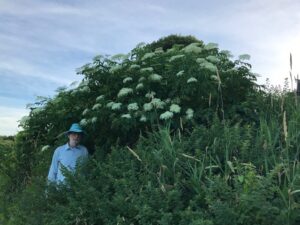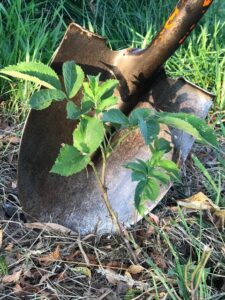Elderberry: For the Birds
This year, with an abundance of spring and early summer rainfall, our native wild elderberries bloomed prolifically. The huge, white flower clusters were visible from afar and lent their charm to the bright green landscape, especially when one knows that there will be lots of berries soon for us and the birds.
Actually, there are two other species of native elderberry in North America. The red elderberry, sometimes also called stinking elder, is a more northern species which I have seen in the boreal forests of Canada and coastal Alaska. Its range extends southward, barely into the northeastern corner of Iowa. In the western states, blue elderberry looks much like our local native except the berries are dark blue instead of the nearly black color of our local species.
Our local species is a favorite for birds. Degraaf and Witman, in their manual titled “Trees, Shrubs and Vines For Attracting Birds” (1979, U. Massachusetts Press, p 140) lists the berries as food for 33 species, cover for 26 species, and nesting sites for five species. And us humans enjoy our share of the berries also. See my July 2017 blog titled “Elderberries,” for a bulk processing method for the berries and a recipe for a great pie.
Should you choose to grow some, my experience is that they mostly just need moist soil and full sun to thrive like those in the preceding photo. I’ve never tried growing them from seed because seedlings appear everywhere; in the woodlot, in old flowerbeds, in the perennial garden, and can be recognized as soon as the leaves appear in spring, when they are ready to transplant. Their growth form consists of tall, somewhat gangly canes which begin bearing the 2nd or 3rd year. They bear for about 4 years and then die, being replaced by younger ones. The plant benefits from pruning out the older canes, which invigorates the younger ones.
Incidentally, there is also a European black elderberry species much like ours, and a Eurasian red elderberry species quite similar to the North American one. In fact, many of our temperate North American tree and shrub species have a temperate Eurasian counterpart. Our basswood is their linden. The Chinese redbud is difficult to tell from the American redbud. We have a beech, they have a beech. The robur oak of Sherwood Forest is so much like our white oak that they cross-pollinate readily. It would take pages to list all the match-ups.
Where the geologic record offers some quality fossils, we often find that the ancestors of these pairs of matched species were already thriving when the two big northern continents were still joined into a single continent. Then after the Atlantic Ocean began to open up, the terrestrial species on either side became isolated from each other and began to gradually evolve in different directions, a process which was still underway until 1492, when people began toting seed and live specimens both ways across the Atlantic, and pollen from not too distant relatives again began to become available. Sometime later this year we will follow-up with a more detailed look at continental drift and some of it’s ecological consequences.
Tags: Bur Oak Land Trust, elderberry, Lon Drake



